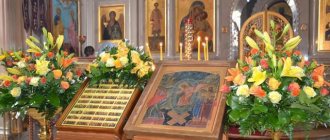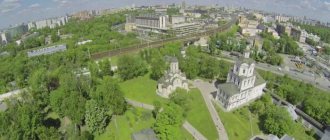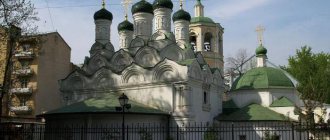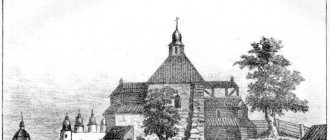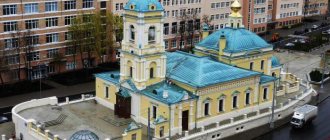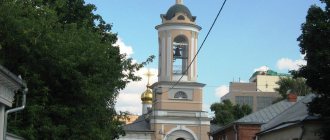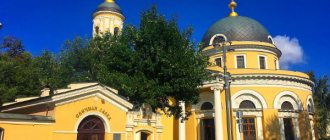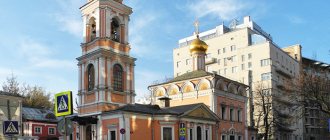The Temple of Boris and Gleb in Degunino became famous for being destroyed and burned many times. Each time, from the ashes, he was reborn anew, like a Phoenix. Today the temple is classified as a monument of Russian architecture and is under state protection.
It has two chapels: St. Nicholas the Pleasant and the icon of the Mother of God “Joy of All Who Sorrow.” The main altar was consecrated in honor of the noble princes Boris and Gleb.
| Temple of the Blessed Princes Boris and Gleb in Degunin | |
| A country | Russia |
| City | Moscow |
| Year of foundation | 1585 |
| Website | hram-bg.ru |
| Abbot | Mitred Archpriest Georgy |
The temple was initially a wooden church with poor decoration
In 1633, a church with a chapel of St. John the Evangelist was built with the money of a local priest. According to historical documents, this is a wooden structure with poor decoration. In the eighties, the church bore the name of the Apostle John the Theologian with a chapel of the holy martyrs and passion-bearers Boris and Gleb.
In 1762, with the funds of the monastery, with the blessing of Metropolitan Timothy, a new wooden single-altar church of Boris and Gleb was built.
1980 The temple building is rented by the Institute of Eye Microsurgery. In 1990 it will be returned to the church
History[edit]
The earliest mention of the village of Degunino in written documents dates back to 1336. This year, Ivan Kalita, in his Spiritual Charter, granted Degunino to Princess Ulyaniya with her small children. In 1353, Grand Duke Simeon the Proud, son of Kalita, bequeathed Degunino to his wife Princess Maria. Finally, in 1389, Dmitry Donskoy refused it to his son, Prince Andrei.
After this, there are no mentions of Degunin for two centuries. However, in the Scribe Book of 1584, a detailed description of the village is given, from which it follows that shortly before that time it was the center of a flourishing estate, on the territory of which 24 “wastelands that were villages” and 3 “wastelands that were villages” are listed. But the oprichnina, the raid of the Crimean Khan Devlet-Girey and the plague epidemic led to the desolation of thousands of villages near Moscow. According to the Scribe Book, Degunino at that time was the patrimony of the Kremlin Church of the Nativity and in it there were “... the church of Boris and Gleb, ancient, ..., at the church, the courtyard of the priests, the courtyard of the church sexton, and three cells, and the courtyard of the archpriest and the brethren.”
During the Time of Troubles, Degunino was devastated, the church was destroyed, and the village again became a village.
Subsequently, Degunino begins to gradually revive. In 1623-1624. it is described as “a village that was the village of Degunino, and in it there was a temple in the name of Boris and Gleb.” In 1633 the church was restored. However, from the decree of 1635 of Patriarch Joasaph, by which he “did not order tribute from the church,” we can conclude that the village was economically weak.
Interior decoration
After forty grace years, tribute was again imposed on the church at the previous salary. But the temple, again inscribed in the Parish books, began to be called this time a little differently: “In the name of the Holy Apostle and Evangelist John the Theologian with the chapel of Boris and Gleb.”
In 1764, by decree of Catherine 11, secularization (alienation) of monastic and church lands was carried out in favor of the state. To manage them, the Board of Economy (Management) was created. Now the peasants of Degunino and the villages adjacent to it have become “economic” and transferred to quitrent. This led to the rapid development of villages. Already in 1770, there were 42 households and 279 residents in Degunin, and 20 households and 137 residents in Verkhniye Likhobory.
The parish, which included the village of Degunino, the village of Beskudnikovo and the village of Verkhniye Likhobory, grew. In 1861 it had 695 inhabitants. The wooden church became cramped, and the clergyman addressed a petition to Metropolitan Philaret in 1863, in which he announced the desire of the parishioners to build a new stone church “near the real wooden one.” Prorekhov agreed to pay the rent in a lump sum, 12 years in advance, with finished products, that is, he supplied 360 thousand bricks required by the project for the construction of the temple.
A stone church in the village of Degunino, made in the pseudo-Russian style, was built next to a wooden one in 1866. The church was picturesquely painted on the walls and vaults, had a rich iconostasis, icons and vestments. There were two large bells on the bell tower.
In 1874, the wooden church still stood next to the stone one. At that time, the wooden one remained Borisoglebsky, and the stone one was consecrated in the name of St. Nicholas the Wonderworker. Two churches stood in Degunino for ten years. It is known that only by 1884 the wooden one was dismantled.
In 1940, the Boris and Gleb Church was closed, its bell tower was dismantled. The church building housed the Rodina knitting factory, which produced tracksuits.
In 1991, the Boris and Gleb Church was returned to the church.
Boris and Gleb Church has two chapels, as well as attached churches and a chapel
The Church of Boris and Gleb in Degunino belongs to the northern vicariate. It includes several ascribed churches located in Moscow in the Degunino area. The Church of St. Seraphim of Sarov is located in the Veltishchev Research Institute of Pediatrics on Taldomskaya Street, building 2.
The Church of the Healer Panteleimon is located in the building of the Bureau of Medical and Social Expertise at 3 Ivan Susanin Street.
Temple of the Icon of the Mother of God “Gerontissa” - at Taldomskaya 6, in the premises of Psychoneurological boarding school No. 25. Next to the Boris and Gleb Church is the Chapel of the Holy Great Martyr Panteleimon.
Activities of the parish[edit]
The church has a library, a Sunday school for children and adults, and a charity group (spiritual and material assistance to psychoneurological boarding schools No. 25 and No. 28).
Responsible for social service - Olga Nikolaevna Brazhnikova: tel.
.
8-963-770-81-62, e-mail:
Responsible for youth work - Priest Andrey Konovalov, assistant - Morozov Alexander Vladimirovich: tel.
+7 963 770 8183,
e-mail:
Sunday school director - Alla Petrovna Gerasimova. e-mail
Passion-bearers Boris and Gleb became the first saints in the Russian Orthodox Church
The temple is named in honor of the great martyrs Boris and Gleb, the sons of the Kyiv prince Vladimir Svyatoslavovich, killed by his own brother Svyatopolk. The brothers knew about the impending death, however, they did not resist the fratricide. Svyatopolk fled to Poland, but even there he could not find peace.
Boris and Gleb are the first saints canonized by the Russian Church. Soon after their death, the princes and great martyrs became guardians and patrons of the Russian land. Raised in the Orthodox faith, they were well educated, read the Bible, lived in piety, and helped the poor.
On May 15, 2018, in the Church of the Holy Martyrs and Passion-Bearers Boris and Gleb in Degunino, a patronal feast took place - the Day of Remembrance of the Holy Blessed Princes Boris and Gleb
Patronal holidays
In the Boris and Gleb Church, patronal feasts are celebrated several times a year, since it is a three-altar shrine. For each such event, the temple is decorated with flowers, dressed in festive vestments, and the most beautiful utensils are prepared. The choir creates a solemn, festive atmosphere.
Both regular clergy and parishioners are preparing for patronal feasts. Even before the holiday, everyone gathers in the church and honors the memory of the saints. Usually, after the cathedral prayer, a procession of the cross is held.
Schedule of patronal holidays:
| May 15 | Transfer of the relics of Boris and Gleb |
| August 6 | Boris' death day |
| September 18 | Day of Gleb's death |
| November 6 | Memorial Day of the Icon of the Mother of God “Joy of All Who Sorrow” |
| December 19th | Memorial Day of St. Nicholas the Wonderworker |
| 22nd of May | Transfer of the relics of St. Nicholas the Wonderworker |
Prince Svyatopolk, who killed his brothers, was expelled from the country
When the brothers grew up, the prince gave Rostov to Boris, and Murom to Gleb. Just before his death, Vladimir summoned Boris, gave him an army and sent him on a campaign against the Pechenegs. Soon the prince died, and his eldest son Svyatopolk declared himself Grand Duke of Kyiv.
He sent assassins to his brothers to rule Russia single-handedly. The brothers accepted death meekly. Boris dismissed his army, saying:
“I won’t raise my hand against my older brother, that’s not Christian.”
Boris's body was taken to Vyshgorod and hidden in the Church of St. Basil the Great.
Gleb also knew about the impending death that overtook him near Smolensk. Having abandoned civil strife, Gleb humbly accepted death following Boris. Yaroslav the Wise, Prince of Kiev found the remains of St. Gleb and placed them next to the relics of Boris in the Church of St. Basil.
Svyatopolk, for his atrocities, was nicknamed the accursed by the people and spent the rest of his life in exile.
Briefly about Degunino
The first mention of the village dates back to 1328. Then Ivan Kalita granted it to the family of Princess Ulyana. After 17 years, Degunino was transferred by Simeon the Proud to his wife Maria. Later it was in the power of Prince Andrei, and only then was it handed over to the Orthodox Church, which ruled the village for 4 centuries.
This is due to the fact that the wife of the deceased Dmitry Donskoy built the Cathedral of the Nativity of the Virgin Mary in honor of her husband, for the maintenance of which his son Andrei gave Degunino along with all the land. Then the village is mentioned 2 centuries later, and is listed as the property of the Church of the Nativity.
During the Time of Troubles (1598 - 1613), Degunino and the church were destroyed. It moved from the status of a village to the status of a village. Restoration was possible only in 1633, but poverty continued to reign in the village. The church was exempted from paying tribute by Patriarch Joasaph for 40 years, which helped Degunino improve his financial situation.
In 1700, the village was given to the Moscow Alekseevsky nunnery, and in 1764 it again became state-owned, and the peasants became economic. In 1863, a railway was built through Degunino, which also contributed to an increase in the standard of living of Degunino residents.
Photo of the village of Degunino
Since the end of the 19th century, Degunino was considered a fairly prosperous settlement. Local residents mainly received income from gardening and the sale of dairy products. In 1960, the village ceased to exist independently, as it became part of Moscow. Some streets and even districts were named in memory of him.
Boris and Gleb Church in Degunino invites everyone to take part in the life of the parish
On weekdays at 8:00 - confession, at 9:00 - Liturgy.
On Sundays and holidays - Liturgy at 7:00 and 10:00.
On Sunday at 16:00 - Akathist to the holy noble princes Boris and Gleb, the Mother of God "Joy of All Who Sorrow" and St. Nicholas the Wonderworker.
Schedule of services on the official website of the temple
This is an approximate schedule and is updated every month. You can follow it on the schedule page.
The current rector is Mitred Archpriest Georgy.
The Church of the Holy Martyrs and Passion-Bearers Boris and Gleb in Degunino is located at Deguninskaya Street, building 18a.
From the Petrovsko-Razumovskaya metro station, take buses 191, 194, 672 to the stop “Institute of Eye Microsurgery.”
By leaving a comment, you accept the user agreement
Temple shrines
The rectors of Moscow churches presented shrines as gifts to the temple. Thus, the donated icon of the great martyr and healer Panteleimon is so miraculous that it cleansed itself and was renewed.
The Calvary Cross was presented - magnificent and unique.
Many parishioners donated their icons. Other icons were painted anew, but had already become prayerful:
- St. Nicholas the Wonderworker with a reliquary;
- Icon of the Most Holy Theotokos “Tikhvin”;
- Matrona of Moscow;
- “Joy to all who mourn”;
- "Inexhaustible Chalice";
- Xenia of Petersburg;
- Spyridon of Trimifuntsky.
Some icons were ordered and painted at the request of parishioners, taking into account their wishes. One of the parishioners brought the “Sign” icon, which was in the church from 1938 until its closure. She saved her, miraculously preserved her.
Painting of the upper temple
Temple of St. Sergius of Radonezh in Businovo
Photo: Church of St. Sergius of Radonezh (businovohram.ru) It is believed that the Church of St. Sergius of Radonezh was built in 1859 with money allocated by Prince Nikolai Obolensky and merchant Ivan Busurin. But its history is older than the building itself. The stone structure replaced the wooden one, erected in the village of Businovo in the 16th century (the first date found in sources and associated with the temple in Businovo is 1584). Initially, the temple was erected in honor of the Great Martyr St. George the Victorious, but the choice of location was determined by the legend of Sergius of Radonezh: according to legend, his path from the Trinity-Sergius Lavra (then called the Trinity Monastery) to Moscow ran through the village of Businovo. He blessed the place, which has since been assigned to the church.
Photo: Church of St. Sergius of Radonezh, 1934 (businovohram.ru) In 1623, the Church of St. George the Victorious fell into disrepair and was dismantled. For twenty years the holy place was empty, and then a wooden temple was erected there, but in the name of Sergius of Radonezh. A century later, rural peasants, using their own resources and resources, renovated the rather shabby building, but by the middle of the 19th century it too had fallen into disrepair. It was then, in 1859, that wood finally gave way to stone. Although, strictly speaking, they began to build the stone temple before the demolition of the wooden one. Only when the work was completed was the old church dismantled and a chapel erected in its place. The main altar, according to tradition, was consecrated in the name of St. Sergius, and the southern and northern aisles - in the name of the Nativity of John the Baptist and St. Nicholas the Wonderworker, respectively. When imperial power changed to Soviet power, the temple was closed, the bell tower was dismantled, the building was rebuilt and turned into a sewing workshop. Until 1990, it resembled Frankenstein’s creation - they demolished something, built on something.
Photo: the temple before restoration, 1990 (businovohram.ru) The Orthodox community tried to return the temple to its intended purpose after the turbulent Soviet period since 1988, but received refusals. Two years later, permission was received. Then restoration work began. The building returned to church status on July 18, 1991, the day of the discovery of the relics of St. Sergius of Radonezh. Now the temple in Businov belongs to the Moscow city diocese of the Russian Orthodox Church. In the Temple of St. Sergius of Radonezh there is an ark containing particles of the relics, vestments and coffin plaque of Patriarch Tikhon of Moscow and All Rus'.
st. Izhorskaya, 1 View on map
+
businovohram.ru

